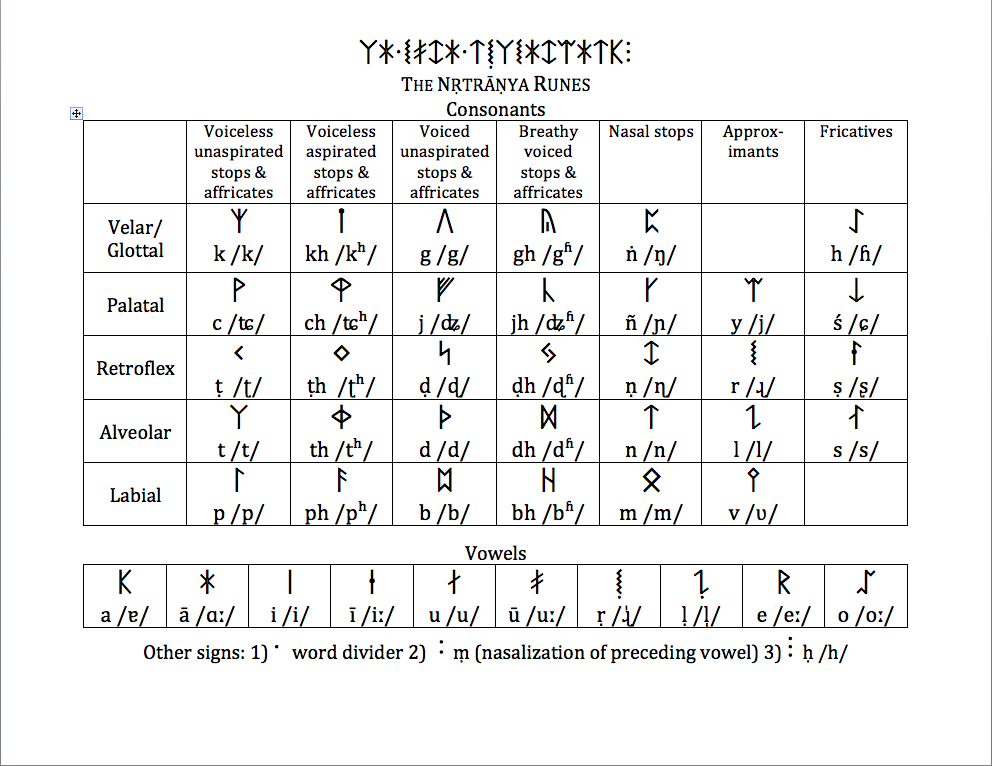Nṛtrāṇya: Difference between revisions
(→Vowels) |
|||
| Line 95: | Line 95: | ||
! style="width: 90px; "| | ! style="width: 90px; "| | ||
! style="width: 90px; " |Front | ! style="width: 90px; " |Front | ||
! style="width: 90px; " |Central | ! style="width: 90px; " |Central | ||
! style="width: 90px; " |Back | ! style="width: 90px; " |Back | ||
|- | |- | ||
! style="" |Close | ! style="" |Close | ||
| i iː | |||
| | | | ||
| | | u uː | ||
|- | |- | ||
! style="" |Mid | ! style="" |Mid | ||
| | | eː | ||
| | | | ||
| | | oː | ||
|- | |- | ||
! style="" |Open | ! style="" |Open | ||
| | | | ||
| | | ɐ | ||
| | | ɑː | ||
|} | |} | ||
===Phonotactics=== | ===Phonotactics=== | ||
<!-- Explain the consonant clusters and vowel clusters that are permissible for use in the language. For example, "st" is an allowed consonant cluster in English while onset "ng" isn't. --> | <!-- Explain the consonant clusters and vowel clusters that are permissible for use in the language. For example, "st" is an allowed consonant cluster in English while onset "ng" isn't. --> | ||
Revision as of 18:08, 14 July 2014
Background
Nṛtrāṇya is a language that I started seriously working on late last year, though as a concept it dates back maybe fifteen or twenty years, and started with the mental question: what would the names of the Æsir be if they had been, in fact, Proto-Indo-European deities who were still worshipped today in India? The concept is simple: to phonologically redesign reconstructed Proto-Germanic as if it were Sanskrit. The motivations are several: first, while the reconstruction of Proto-Germanic (and even more so Proto-Indo-European) is beset by uncertainties, the phonology of Sanskrit is very well known, and is of such a nature as to iron out many dubious points; second, by making a Germanic language that is more Sanskrit-like, it makes structural comparison between Germanic languages and Sanskrit straightforward, avoiding phonological issues; third, it's a somewhat satirical take on the efforts of certain 19th-century popularizers of linguistics to post Sanskrit as the Ursprache of the Indo-Europeans — or, as the German scholars oddly called them, Indogermanen.
Within its imaginary world, "Artā" (sc. Earth), Nṛtrāṇya (northern (speech)) is an extinct language spoken around 2500-2700 years before the present by the Nṛtramanvānaḥ (north-people), the inhabitants of Nṛtravahaḥ, a large complex of islands situated just below the Arctic circle. It was closely related to languages of the mainland just to the south, and due to the influence of a religious movement originating there, became a liturgical language and language of lore for many people speaking other languages, related and unrelated. The language as described here, however, is of the 'pagan' period immediately before the rise of that movement, when the language was still very unified and spoken almost exclusively in the Nṛtravahaḥ.
-->
Phonology
The phonological inventory of Nṛtrāṇya is basically identical to that of Sanskrit, as is its phonological history; the major exception is that the consonants /l/ and /r/ were not confused at any point in the development of the language.
Consonants
| Bilabial | Dental | Retroflex | Palatal | Velar | Glottal | |
|---|---|---|---|---|---|---|
| Nasal | m | n | ɳ | ɲ | ŋ | |
| Plosive | p pʰ b bʱ | t tʰ d dʱ | ʈ ʈʰ ɖ ɖʱ | k kʰ ɡ ɡʱ | ||
| Fricative | s | ʂ | ɕ | h ɦ | ||
| Affricate | ʨ ʨʰ ʥ ʥʱ | |||||
| Approximant | ʋ | ɻ | j | |||
| Lateral fric. | l |
Vowels
| Front | Central | Back | |
|---|---|---|---|
| Close | i iː | u uː | |
| Mid | eː | oː | |
| Open | ɐ | ɑː |
Phonotactics
Orthography
Nṛtrāṇya was originally written in an alphabet carved into stone and wood; paper and parchment were not known until very late. It is transcribed in a conventional orthography based on that used for Sanskrit and other Indic languages. The Nṛtrāṇya "runes" were usually written from left to right, but occasionally boustrophedon (with reversals in direction with each line), in which case the asymmetrical characters would have been reversed when writing right-to-left.
